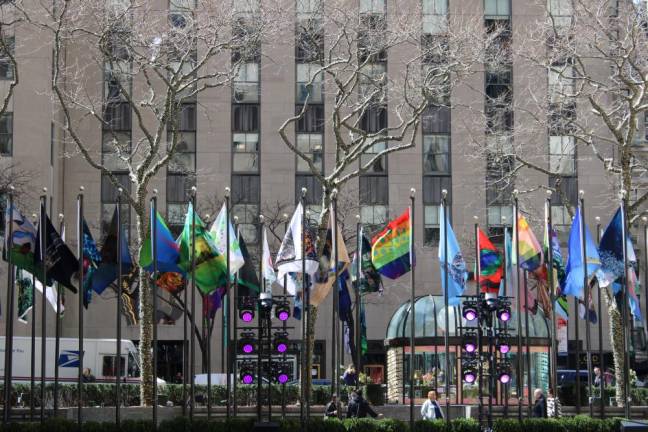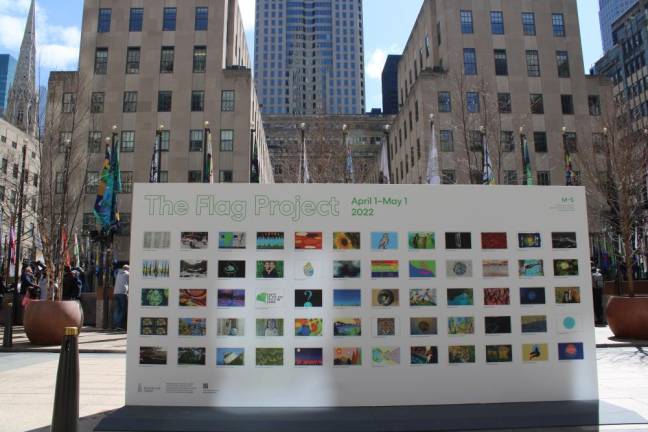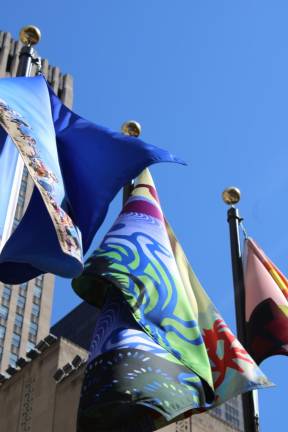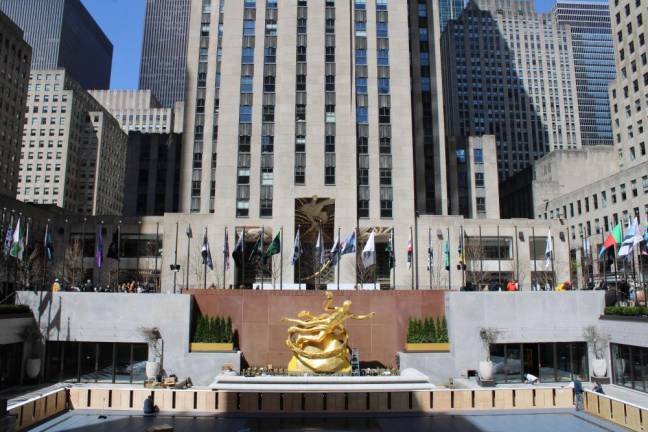‘Only One Earth’: Rockefeller Center’s Flag Project on Climate Change
The installation showcases how art can inspire positive environmental action




The flags at Rockefeller Center wave in the wind, rippling in a kaleidoscope of designs. The colorful flags ring the central plaza and people wander around the area, snapping pictures and pointing out their favorite ones. In between the business complex and the iconic Prometheus statue sit two long white boards, which provide information about the installation as well as the images printed on each flag.
The Flag Project originally started in 2020 as an art initiative to highlight the city’s diverse culture. In 2021, Rockefeller Center partnered with the Aperture Foundation to show New York’s “faces, icons, and textures” through photography. This year in partnership with The Climate Museum and the United Nations Environment Programme (UNEP), the Flag Project has taken on “Only One Earth,” centered on environmental awareness and climate action.
“The Flag Project has quickly become one of Rockefeller Center’s most beloved events. It’s an important opportunity for artists of all ages, near and far, to share their visions for our one earth,” said EB Kelly, Managing Director and Head of Rockefeller Center at Tishman Speyer in a quote on the Flag Project’s installation board.
The Climate Museum regularly collaborates with artists on projects and uses art to raise awareness about climate issues. With a seasonal residency on Governors Island, the museum curates installations and organizes events throughout New York City.
“We were thrilled to be a part of this project especially because it focuses on the power of art to build community and inspire climate action, two essential components of our mission at the museum,” said Saskia Randle, a Design and Curatorial Associate at the Climate Museum.
The project comes in a critical year for climate with UNEP’s 50th anniversary and the upcoming Stockholm +50, an international climate meeting held this June in Stockholm, Sweden. The project also follows a recent report from the United Nations Intergovernmental Panel on Climate Change (IPCC) which provides an assessment on climate change every six to eight years. The report stated in bleak terms that nations around the world aren’t currently doing enough to prevent disastrous impacts of global warming from impacting the lives of most people alive today. The report provided recommendations for policymakers and said while curbing emissions won’t be easy, it’s essential that countries act now.
“Wide Range of Voices”
Each of the 193 flags showcases an original image depicting what the environment means to the artist. In creating these images, artists were asked to think creatively about how they make positive climate action in their daily life. The project was open to interpretation and anyone who was interested was encouraged to submit their work. “We wanted it to be accessible because that’s what we need in order to move forward on climate, a wide range of voices and different ways for people to engage,” said Randle.
María Verónica San Martín, an artist and educator, submitted a design she made with her eight-year-old son Salvador in March 2020 during the chaos of the first wave of the COVID-19 pandemic. Their image shows two hands uniting in the shape of the earth with arms on top of an ocean horizon. “We reimagined the idea of combining human life with nature through softening our impact on climate to protect mama earth,” said San Martín.
The image portrays a hand of an older generation with that of the younger generation that will inherit the earth, emphasizing how crucial collective action is for long term environmental sustainability. “We only have one earth, and we have to take care of it,” said Salvador. “You help just by picking up garbage and recycling it.”
While flags are associated with national and institutional identity, San Martín says the flags as objects show how the environment and concept of sustainability encompasses all identities and knows no borders. The cycle of nature is also present within the life of the flags as they are made out of biodegradable fabrics from the textile company CiCLO.
“The majority of Americans are worried about the climate crisis but don’t feel like they have a way to engage with it. There’s a lot of reasons for that. It’s super overwhelming and you can feel so alone because of the scale of the crisis. Projects like this provide an accessible pathway to starting conversations about it and allow people to contribute in a way that’s meaningful,” said Randle.
She also points out that projects like the one at Rockefeller are an excellent example of how businesses and organizations can mobilize their influence to start conversations about climate change and encourage others to do the same.
The “Only One Earth” installation will be open to the public through May 1, excluding April 14 – 17 (for the grand opening of Flipper’s Roller Boogie Palace at Rockefeller Center for seasonal rollerblading).